![]()
![]()
![]()
Use LEFT and RIGHT arrow keys to navigate between flashcards;
Use UP and DOWN arrow keys to flip the card;
H to show hint;
A reads text to speech;
10 Cards in this Set
- Front
- Back
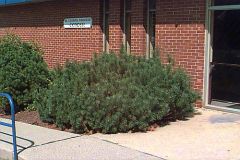
Pinus mugo
|

Mugo Pine
Habitat • native to mountainous areas in Central and Southern Europe • cold hardy to zone 2 Habit and Form • evergreen dwarfed tree • dense shrub growth habit to multi-trunked tree • varies in size from 5 to 20', with equally varying spread • some specimens have reached 50' tall • medium texture • slow growth rate Summer Foliage • rigid and slightly curved needles • needles in fasicles of 2's • margins serrate • needles 1 to 2" long • bright green color Autumn Foliage • no fall color (remains green) • needles persist 5 years Flowers • monoecious • no ornamental value Fruit • dark gray cone • ovoid, 1 to 2" long • held in clusters of 2 to 4, or found alone • tip of cone surrounded by a darker ring |
|
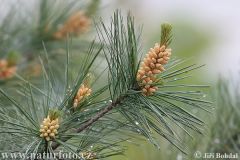
Pinus strobis
|

Eastern White Pine
Habit and Form • evergreen tree • conical in form when young, losing a defined shape with age, becoming picturesque • 50 to 80' tall by 30-50' wide, can reach well over 100' tall. • many lateral branches creates a moderately dense canopy • fine texture • fast growing Summer Foliage • light green with a bluish cast • 5 needles per fasicle • thin flexible needles, 4" long • serrated margins and two stomatal lines on underside Autumn Foliage • no fall color (remains green) • needles persist for 2 years Flowers • monoecious • no ornamental value Fruit • light brown cones, often numerous • cones are 6-8" long • curved with a pointed tip • takes two years for cones to reach maturity • cones typically clustered in the upper third of the tree |
|
|
Pinus strobus Dwarf Group
|
Dwarf Eastern White Pine
|
|
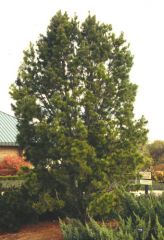
Pinus bungeana
|

Lacebark Pine
Habitat • native to northern and central China • cold hardy to zone 4 Habit and Form • evergreen tree • multi-trunked with an open broad form with age • shrubby when young • 30 to 40' tall with a similar spread • medium to fine texture • slow growth rate Summer Foliage • 3 needles per fasicle • 2 to 4" in length • medium green needles, waxy or "plastic"-looking • stiff, pointed needles • raised midrib • serrated margins Autumn Foliage • no fall color (remains green) • needles persist 4 years Flowers • monoecious • no ornamental value Fruit • tawny brown cone • oval, 2 to 3" long • scale is broad with a triangular spine Bark • exfoliates to reveal brown, rust, green, and cream bark • highly ornamental • new stems are green to gray and are fairly thick |
|
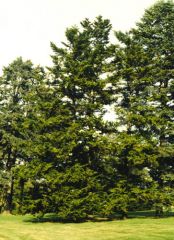
Abies homolepis
|

Nikko Fir
Abies homolepis Habitat • native to Japan • zone 5 Habit and Form • evergreen tree • 30' to 50' tall and somewhat narrow; can grow to 100' or more • tree is densely covered in branches from base to top • pyramidal in shape even in old age • medium texture Summer Foliage • roughly 1" long • entire margins • glossy, dark green • 2 broad stomatal bands on underside • needle apex is notched • needles densely cover stem, denser than most firs • needles held horizontally on branch are longer than those held vertical. Autumn Foliage • no fall color (evergreen) Flowers • no ornamental value • monoecious Fruit • light brown cones • 4" long • cylindrical in shape • hidden bracts Bark • new stems are yellow with an indented diamond pattern • new stems are glabrous • older bark is rough and scaly • brown in color • young bark is smooth with resin blisters |
|
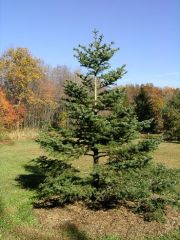
Abies cephalonica
|

Greek Fir
Description: A broadly pyramidal tree; a narrow-leaved evergreen Needles: Spirally arranged, dark shiny green above, greenish-white below; flattened in cross-section; tips are sharply pointed; 15-35 mm long by 2-3 mm wide Cones: Male cones ovoid, 14 mm long by 4 mm wide. Female cons are narrowly cylindrical, brownish-red to violet, somewhat resinous, 12-16 cm long by 3.8 cm wide. Cones are golden brown in color. Bark: Grey-brown, smooth but becoming fissured into oblong plates Branching Pattern: Height: 30 meters Conditions/Habitat/Kind of Forest: Prefers partial shade or partial sun to full sun and moist soil. Range: Greece Zone: 5 Conservation Status-US/ World Wide: Not threatened Uses (Human): Used for construction, pulp Location: Common Name: Greek Fir or Meyer's Dwarf Family: Pinaceae |
|
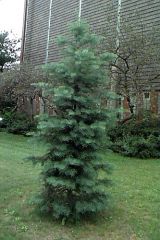
Abies concolor
|

Concolor Fir
Abies concolor Habitat • native to the Rocky Mountains of the western United States; from Canada to California • zone 3 Habit and Form • evergreen tree • 50' to 75' tall by 20' to 30' wide, but can reach over 100' tall • pyramidal in shape, holding a dense, formal shape well, even with age • medium to coarse texture • slow to medium growth rate Summer Foliage • needles are 2" to 3" long • needles arranged horizontally on the stem, curving up and out, much like a "rib cage" • needles are glaucous on both-sides giving it a blue cast to the upper and underside • needles have 2 white stomatal lines on underside • buds are resinous Autumn Foliage • no fall color (evergreen) Flowers • no ornamental value • monoecious Fruit • brown cones, green when immature • cylindrical • 4" to 5" long • cones shatter when mature • cones borne on the upper third of the tree Bark • smooth, except for occasional resin blisters • bark has a whitish gray color • new stems are yellow-green in color and are somewhat hairy |
|
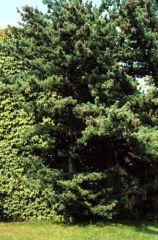
Pinus parvaflora
|

Japanese White Pine
Pinus parviflora Habitat • native to Japan • zone 4 to 7 Habit and Form • evergreen needle conifer tree; small to medium size • 25 to 50' tall in U.S. • as wide as tall • young trees dense and conical • older trees develop picturesque form • become flat-topped with lower branches shorter than upper branches Summer Foliage • needles in 5's • 1.5 to 2.5" long, stiff and twisted • appear in brush-like tuft on branches • bluish-green color Autumn Foliage • same as summer foliage Flowers • blooms in May • small, yellow-green flowers in clusters Fruit • brownish-red 1.5 to 4" cones • persist 6 or more years • often produced in abundance evergreen on young trees Bark • smooth, gray when young • stems greenish-brown, very slightly downy first year • older bark dark gray, and scaly platy |
|
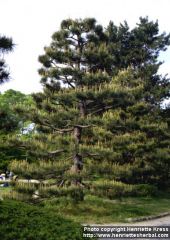
Pinus thunbergii
|

Japanese Black Pine
Pinus thunbergii Description Japanese black pine is a distinctive and picturesque evergreen with an open, irregular structure. The branches are large and contorted, horizontally spreading and sometimes pendulous. The foliage tends to be concentrated near the tips of the branchlets. Japanese black pine generally gets 20-30 ft (6-9 m) tall in cultivation, but can get over 100 ft (30.5 m) tall in its native habitat. Japanese black pine has fairly stiff dark green needles 3-5 in (7.6-12.7 cm) long in sheaths of two. It usually sports silvery white "candles" - young fast-growing upright shoots. The candles really stand out against the dark green foliage. Many cultivars have been selected, especially in Japan, and most are difficult to obtain in the U.S. 'Thunderhead' is compact, with dense foliage and stays under 10 ft (3 m) tall. The needles of 'Oculus-draconis' have yellow crossbands. 'Iseli' has needles edged with yellow. 'Kotobuki' is smaller with short needles. There are several dwarf cultivars selected for bonsai. Location Japanese black pine is native to northeastern China, Korea and Japan. It's a popular landscape tree in Japan and in coastal gardens in northern Europe and the northeastern U.S. Culture To shape pine trees, prune away half of the new candle in spring and the shoot will develop side branches; then you can select which side branches to keep. Light: Full sun. Moisture: Japanese black pine is quite tolerant of drought and requires a well-drained soil. It does very well in sand. Hardiness: USDA Zones 5 - 8. Zone 5 and 8 are the extremes; Japanese black pine seems to do best in zones 6 and 7. Propagation: Seeds germinate readily. Cuttings and grafting can be used for cultivars, but the success rate is usually very low. Usage Japanese black pine is very tolerant of high winds and salt spray - an excellent evergreen for the coastal and even the seaside garden. Use this tough pine in exposed situations, where it develops its most picturesque form. Japanese black pine has been used to stabilize sand dunes. It also is reported to be tolerant of urban conditions. Features |
|

Pinus densiflora
|

Dragon's Eye Pine
Pinus densiflora "Ocular Draconis' Habitat • native to Japan • cold hardy to zone 4 Habit and Form • evergreen tree • often a multi-trunked tree, with broad irregular growth • up to 100 ft. tall, usually half that, with an equal spread • medium texture • slow growth rate Summer Foliage • soft flexible texture • 2 needles per fasicle • margins serrate • needles twisted and roughly 3-4" long • bright green in color, looks like they are plastic • needles appear in bunches along the top of the stem Autumn Foliage • no fall color (remains green) • needles persist 3 years Flowers • monoecious • no ornamental value Fruit • tawny yellowish brown cone • oval to oblong, roughly 2" long • found alone or in clusters • tree has a tendency to hold cones for a 2 years Bark • young bark peels in thin scales to reveal a reddish color • older bark is gray, typically seen on the main trunk |

